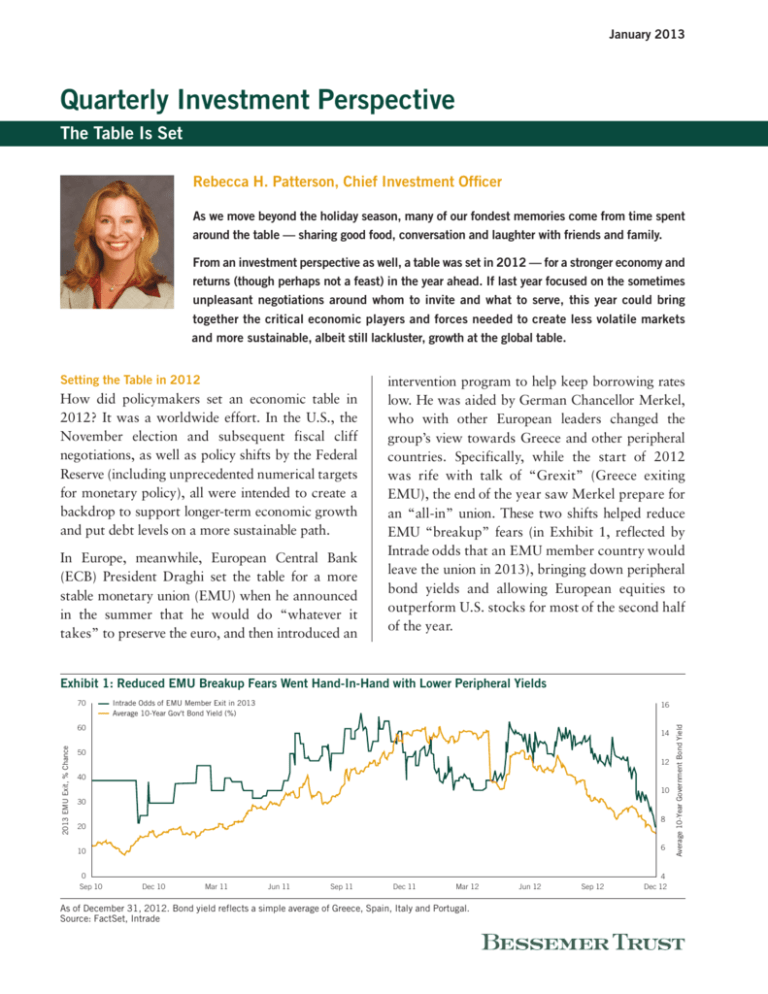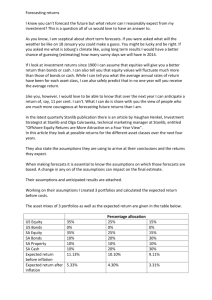
January 2013
Quarterly Investment Perspective
The Table Is Set
Rebecca H. Patterson, Chief Investment Officer
As we move beyond the holiday season, many of our fondest memories come from time spent
around the table — sharing good food, conversation and laughter with friends and family.
From an investment perspective as well, a table was set in 2012 — for a stronger economy and
returns (though perhaps not a feast) in the year ahead. If last year focused on the sometimes
unpleasant negotiations around whom to invite and what to serve, this year could bring
together the critical economic players and forces needed to create less volatile markets
and more sustainable, albeit still lackluster, growth at the global table.
Setting the Table in 2012
How did policymakers set an economic table in
2012? It was a worldwide effort. In the U.S., the
November election and subsequent fiscal cliff
negotiations, as well as policy shifts by the Federal
Reserve (including unprecedented numerical targets
for monetary policy), all were intended to create a
backdrop to support longer-term economic growth
and put debt levels on a more sustainable path.
In Europe, meanwhile, European Central Bank
(ECB) President Draghi set the table for a more
stable monetary union (EMU) when he announced
in the summer that he would do “whatever it
takes” to preserve the euro, and then introduced an
intervention program to help keep borrowing rates
low. He was aided by German Chancellor Merkel,
who with other European leaders changed the
group’s view towards Greece and other peripheral
countries. Specifically, while the start of 2012
was rife with talk of “Grexit” (Greece exiting
EMU), the end of the year saw Merkel prepare for
an “all-in” union. These two shifts helped reduce
EMU “breakup” fears (in Exhibit 1, reflected by
Intrade odds that an EMU member country would
leave the union in 2013), bringing down peripheral
bond yields and allowing European equities to
outperform U.S. stocks for most of the second half
of the year.
Exhibit 1: Reduced EMU Breakup Fears Went Hand-In-Hand with Lower Peripheral Yields
Intrade Odds of EMU Member Exit in 2013
Average 10-Year Gov't Bond Yield (%)
16
2013 EMU Exit, % Chance
60
14
50
12
40
10
30
8
20
6
10
0
Sep 10
Dec 10
Mar 11
Jun 11
Sep 11
Dec 11
Mar 12
As of December 31, 2012. Bond yield reflects a simple average of Greece, Spain, Italy and Portugal.
Source: FactSet, Intrade
Jun 12
Sep 12
4
Dec 12
Average 10-Year Government Bond Yield
70
The Table Is Set
Feast or Famine in 2013?
As 2013 begins, we are asking ourselves what
happens now that the global table has been set.
Taking the analogy a step further, will investors be
more likely to find a feast or famine in the year ahead?
Looking at the U.S., we sadly do not expect a feast for
investors, at least early in the year. Fiscal tightening in
2013 will weigh on growth — probably taking about
1% from GDP. Further, while the U.S. avoided the
full “fiscal cliff,” the deal struck suggests that any
agreement on spending (likely including entitlement
reform) will be tied to a needed increase in the debt
ceiling. The potential for another government
showdown — even more dramatic than those seen
in July 2011 or December 2012 — could turn the
market’s stomach, so to speak, at least for a while.
(Recall that in the aftermath of the 2011 U.S.
sovereign credit downgrade, the S&P 500 fell 17%
in just 12 trading days.)
That said, our caution towards Washington should
be taken in context — we would highlight two
factors in particular that leave our macro view
2
Second, we believe consumers may continue to find
at least a partial offset to higher taxes (Exhibit 2)
from both lower gasoline prices (down more than
16% between September and end-December,
helped by better supply expectations, in turn tied in
part to advances in U.S. drilling technology) and
improving home prices (home values comprise a
major portion of the average American’s net worth).
Assuming these trends continue (our base case)
and that consumers are willing to dip into savings
somewhat, we could see retail sales hold up better
than expected in the year ahead.
Exhibit 2: Tighter U.S. Fiscal Policy Offset to a Degree
from Housing and Gasoline Prices
50
Housing
Gas Prices
4.00
3.80
40
3.60
30
3.40
20
3.20
10
0
Dec 11
Median Gas Price ($)
During the second half of 2012, our portfolios
benefited both from the relative improvement in
sentiment towards Europe and parts of Asia, as
well as from a search for yield heightened by
central bank efforts. The latter led to continued
strong performance in high-yield corporate debt,
emerging-market debt and mortgage-backed securities, while the former supported non-U.S. equities.
more balanced for the year overall. First, a lackluster
pace of growth is already a consensus view on
Wall Street (as of year-end, consensus estimates
put 2013 U.S. GDP growth at 2%). We believe
U.S. asset prices already reflect at least some of
this growth outlook. In fact, we’d highlight that,
historically, sub-trend U.S. growth did not correlate
well with equity returns — while such periods
have seen more volatility in equity performance,
on average, the S&P 500 has still risen in such
environments (including a 16% gain in 2012 despite
GDP growth around 2.2%).
NAHB Housing Market Index
In Asia, table setting was especially pronounced
in China and Japan — both countries saw new
leaders outline their respective economic goals. In
Japan’s case, that meant more stimulus and a
weaker yen. Indeed, the Japanese TOPIX index
surged nearly 20% just between mid-November
and year-end, largely on expectations for such policy
action. In China’s case, new leaders reinforced dual
goals — sufficient growth but controlled inflation,
and a relative rebalancing toward domestic demand
at the expense of exports.
3.00
Feb 12
Apr 12
Jun 12
Aug 12
Oct 12
2.80
Dec 12
As of December 31, 2012.
Source: National Association of Realtors, U.S. Department of Energy
One wild card for the U.S. this year is corporate
behavior. Last year saw business sentiment improving, but CEOs still reluctant to spend; indeed,
cash as a percentage of total assets remained near
Bessemer Trust Quarterly Investment Perspective
The Table Is Set
Exhibit 3: For Now, Corporate Spending Looks Unlikely to Boost U.S. Growth
Estimated Capital Expenditures for the Next Six Months
40
30
Index
20
10
0
(10)
Philly Fed
Empire State
Recessions
(20)
2000
2001
2002
2003
2004
2005
2006
2007
2008
2009
2010
2011
2012
As of December 31, 2012.
Source: Federal Reserve
multi-decade highs (around 11%). While the fiscal
cliff resolution may set the table for slightly less
corporate angst, we have yet to see evidence that
U.S. firms are about to ramp up hiring and/or capital expenditures — especially given still-uncertain
outlooks for corporate tax policy. As of December,
business sentiment surveys showed that corporate
spending plans over the coming six months
remained near cyclical lows, a view likely to be
reflected in the coming earnings season as well
(Exhibit 3).
We would expect that a material improvement in
corporate behavior, if and when it emerges, will be
well telegraphed through sentiment surveys and
corporate guidance. We would see any such shift
by corporate America as key for a faster, broader
U.S. economic recovery, and in turn upside potential
for related equities.
What about Europe? The table may look more
attractive now, but in our view, investors still need to
be careful not to overindulge. While the European
political elite and ECB seem intent on limiting
downside risk (in our view, at least until the autumn
German elections), the region still faces stagnant
(and in some cases, negative) growth and mountains
of debt. Indeed, the European Commission last
month estimated that EMU debt, at 92.8% of GDP
in 2012, would only fall to 88.6% in 2020 — the
January 2013
commission’s outlook suggested a euro area with
at least 20 years of debt/GDP well above the
Maastricht Treaty guideline of 60%.
A continued, needed focus on reducing debt seems
likely to prevent a stronger growth recovery anytime
soon. Fragile growth and high unemployment rates
(the EMU jobless rate reached a record 11.8% in
November 2012) will keep EMU vulnerable to
shocks — be they external (such as a renewed
bout of Middle East stress that suddenly lifts oil
prices) or internal (possible uncertainty around
Italy’s upcoming election).
A potentially more stable, even stronger, U.S.
economy, at the margin, could help Europe, both via
general risk appetite as well as trade. So too would
an improving Asia. In Asia’s case, we expect both
China and Japan (the region’s largest economies) to
post improving economic numbers in the months
ahead, albeit relative to a soft 2012. Indeed, such an
improvement in China is already starting to be
reflected in business sentiment surveys and industrial
production (Exhibit 4).
In China, we believe leaders will pursue both policy
stability and sustainable growth, while in Japan,
the new Liberal Democratic-led government seems
likely to take more steps to extinguish deflation
once and for all, in part by actively encouraging a
weaker yen.
3
The Table Is Set
Exhibit 4: Improving Industrial Production Bodes Well
for Chinese GDP
China GDP YoY %
China Industrial Production
22
12
20
11
18
16
10
14
9
12
8
10
7
8
6
5
2006
China Industrial Production Growth
China GDP Growth (% YoY)
13
6
4
2007
2008
2009
2010
2011
2012
As of November 30, 2012.
Source: Bloomberg, Federal Reserve
What’s on the Menu? Portfolio Implications
As we consider our 2013 macroeconomic views, the
table laid before us, so to speak, at least five key
portfolio implications emerge.
• Remain underweight traditional fixed income,
and consider hedge funds a complement to bonds
as a way to manage volatility.
• Stay overweight in credit and extended fixed
income — “yield-focused investments.”
• Preserve global equity exposure — with a tilt
towards non-U.S. large cap firms.
• Where appropriate, use private equity and real
estate to capture specific investment opportunities
and portfolio diversification.
• Don’t overlook inflation and event-risk hedges.
To be frank, we do not see much value in traditional,
developed-market government bonds. The Federal
Reserve, ECB and Bank of Japan may be working
hard to keep bond yields from rising, but a further
decline in yields (and support for prices) seems very
limited simply given current valuations. We maintain
a maximum underweight here in our Balanced
Growth portfolio. That said, we would be reluctant
to get rid of bonds — historically, and in our view,
for the foreseeable future, they effectively cushion
losses from falling equity markets as investors seek
liquidity and safety. Over time, that balance helps
manage portfolio volatility.
4
But what happens when these markets see yields rise
on a more sustained basis, optimistically if growth
gains more traction? While such a shift does not feel
likely near-term, with continued fiscal tightening
weighing on growth, we know such a day is coming.
With that in mind, and looking around the investment
universe for other assets with low volatility, we
consider hedge funds. Certainly they do not offer
the same liquidity or cost as government bonds, but
at least at Bessemer, a well-designed hedge fund portfolio has helped reduce volatility with respectable
returns. We would not consider hedge funds a
replacement in any way for bonds, but they can
serve as a complement.
Beyond hedge funds, we also believe that we can
continue to find attractive opportunities and more
muted volatility through a number of other investments. Specifically, we remain overweight extended
fixed income and credit, including local-currency
emerging-market debt, high-yield U.S. corporate
debt and mortgage-backed securities. Given how
much these investments have gained in recent years
(emerging-market spreads over U.S. Treasuries have
narrowed 160 basis points since the beginning of
2012), we expect returns in 2013 to be more
modest (Exhibit 5). That said, with central banks
determined to keep monetary policy extremely
easy and investors searching for yield, we believe
demand will still outstrip supply once again to keep
prices supported.
Yield is a factor that also should help equities in
2013. Equity dividend yields have now surpassed
10-year government bond yields in a number of
developed markets (in the U.S., the S&P’s 2.6%
yield in early January dwarfed a 10-year bond yield
around 1.85%). Further, many firms with excess
cash are growing dividends faster (in the U.S., at
the fastest pace in six decades). Indeed, for 2012,
S&P 500 cash dividends are estimated to have
been 13% above the previous record set in 2008,
even without counting dividends paid in December
for tax reasons.
Bessemer Trust Quarterly Investment Perspective
The Table Is Set
Exhibit 5: Strong Recent Returns from Yield-Focused Investments
Post Financial Crisis (Since 2009)
Asset Class
Global Equities
U.S. Treasuries
High-Yield Bonds
Convertible Bonds
Emerging-Market Bonds
Hedge Funds of Funds
Annualized Return
Annualized Volatility
14.4%
3.9
21.7
13.5
16.6
2.1
19.5%
8.1
9.9
12.0
6.8
4.1
As of December 31, 2012.
Source: HedgeFund.net, J.P. Morgan, Merrill Lynch, Standard & Poor’s, UBS, United States Department of the Treasury
Beyond growing dividends, corporations are helping
the stock market in another way: share buybacks.
With cash levels high and risk appetite low, both
dividend and buyback trends are likely to continue.
While these factors may help equity returns in
2013, we still expect bouts of indigestion during
the year — in the U.S., for instance, anxiety about
the debt-ceiling and spending debates this quarter
could limit S&P gains. With that in mind, we
continue to keep a slight tilt towards non-U.S.
stocks, including emerging-market equities that
we expect to benefit from improving growth
trends and still-attractive valuations.
We see value this year not only in public equity but
also in private equity, especially for investors with
longer time horizons and relatively modest liquidity
needs. In particular, we believe that certain investment themes are more effectively accessed via private
equity — including structural growth in the emergingmarket consumer, early-stage tech companies and,
in some cases, real assets.
Finally, as we look across asset classes, we continue
to think about and position for “what ifs”: What
if Washington gridlock worsens? What if tensions
in the Middle East rise? What if weather wreaks
havoc with global crops? As we begin 2013, we
continue to look for opportunities to protect
January 2013
portfolios, in part via equity and commodity derivative positions (Exhibit 6). If recent years have taught
us anything, it’s that we should expect surprises.
We are doing what we can within the investment
team to make sure any “flies in the soup” do not
ruin what otherwise should be a good meal.
Exhibit 6: Combining Growth and Protection
Balanced Growth Portfolio Asset Allocation
Growth
Defensive Growth
Bonds
22%
Protective
Large Cap Equities
23%
Cash
2%
Hedge Funds
12%
Small & Mid
Cap Equities
13%
Credit
9%
Private Equity
10%
Commodities Real Estate
4%
5%
As of December 31, 2012.
This model displays Bessemer’s suggested model portfolio allocation
guidelines. Each client situation is unique and may be subject to special
circumstances, including but not limited to greater or less risk tolerance,
classes and concentrations of assets not managed by Bessemer, investment
limitations imposed under applicable governing documents, and other
limitations that may require adjustments to the suggested allocations.
Model asset allocation guidelines may be adjusted from time to time on
the basis of the foregoing or other factors.
Alternative investments, including Bessemer private equity, real estate,
and hedge funds of funds, are not suitable for all clients and are available
only to qualified investors.
5
THIS PAGE INTENTIONALLY LEFT BLANK
THIS PAGE INTENTIONALLY LEFT BLANK
This material is for your general information. It does not take into account the particular investment objectives, financial situation, or needs of individual
clients. This material is based upon information obtained from various sources that Bessemer Trust believes to be reliable, but Bessemer makes no
representation or warranty with respect to the accuracy or completeness of such information. Views expressed herein are current only as of the date
indicated, and are subject to change without notice. Forecasts may not be realized due to a variety of factors, including changes in economic growth,
corporate profitability, geopolitical conditions, and inflation. The mention of a particular security or asset class is not intended to represent a specific
recommendation, and our views may change at any time based on price movements, new research conclusions, or changes in risk preference.
Atlanta • Boston • Chicago • Dallas • Denver • Los Angeles • Miami
New York • Palm Beach • San Francisco • Washington, D.C. • Wilmington
Cayman Islands • New Zealand • United Kingdom
Visit us at www.bessemer.com.
Copyright © Bessemer Trust Company, N.A. All rights reserved.
•
•
Naples
Woodbridge








